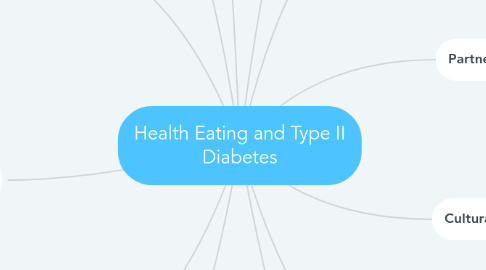
1. Health Education
1.1. Cognitve
1.1.1. Nurse explains what diabetes is and what happens in your body
1.2. Affective
1.2.1. Nurse tries to help patients value eating healthy and exercising
1.3. Psychomotor
1.3.1. Teaching how to give insulin injections
2. Self-Management
2.1. Self-efficacy
2.1.1. Having the confidence in one’s knowledge and ability to make a lifestyle change
2.2. Disease management
2.2.1. Diabetics may need a system of health care interventions and communications to help them manage their chronic condition
2.3. Social Cognitive Theory
2.3.1. Thoughts influence behavior. Recognizing that a change needs to be made is the first step in managing diabetes
3. Innate Psychological Needs
3.1. Relatedness
3.1.1. Having a close support system and feeling valued will encourage someone to make a change
3.2. Autonomy
3.2.1. Feeling a sense of ownership over one’s actions will help an individual adhere to a new diet or exercise routine
3.3. Competence
3.3.1. Mastering a behavior by educating yourself on diabetes prevention
4. Social Ecological Model
4.1. Further the understanding of the dynamic interrelations among various personal and environmental factors than contribute to type 2 diabetes
5. Family Dynamics
5.1. Genogram
5.1.1. Assessing family health history. Gives individuals the knowledge of knowing if they are possibly at risk for diabetes
5.2. Family functions
5.2.1. Economic
5.2.1.1. Family income plays a large role in daily diet and availability to exercise
5.2.2. Health care
5.2.2.1. Diabetics that maintain their health and manage their illness can reverse the effects of the disease
6. Health Determinants
6.1. Biological/genetic
6.1.1. Type 2 diabetes can be hereditary
6.2. Behavioral
6.2.1. Stress can keep an individual from proper exercise and diet
6.3. Social
6.3.1. Socioeconomic status can prevent individuals from proper healthcare and a healthy diet
7. Health Promotion
7.1. Promote health change and reinforce behavior
7.1.1. Lose weight
7.1.2. Exercise
7.1.3. Healthy eating behavior
7.1.4. Lessen alcohol and tobacco use
8. Health Prevention
8.1. Primary Prevention
8.1.1. Primary prevention when the individual is not prediabetic but is still at risk for type II diabetes
8.2. Secondary Prevention
8.2.1. Prediabetic individuals are considered to be part of secondary prevention, since it is focused on prompt intervention (healthy eating) to prevent a formal diagnosis of type II diabetes
9. Partnership
9.1. Prediabetics or diabetics need to be active participants in their own healthy change
9.2. Collaboration
9.2.1. Developing partnerships to achieve the best outcome that reflect on the needs of the individual with diabetes, their family, and their community
10. Cultural Congruent Care
10.1. Lower risk
10.1.1. Non-Hispanic whites
10.2. Higher risk
10.2.1. African Americans
10.2.2. Native Americans
10.2.3. Hispanic Americans
11. Mood, Stress, & Coping
11.1. Stress
11.1.1. Negatively effects lifestyle by taking away from smart nutritional choices and exercise
11.2. Coping
11.2.1. Problem-focused
11.2.1.1. Finding a solution to lose weight or make other lifestyle changes
11.2.2. Emotion-focused
11.2.2.1. Journaling or discussing aspects of one's diabetes to alleviate stress
11.2.3. Meaning-focused
11.2.3.1. Changing one's values or beliefs to make lifestyle changes
12. Growth and Development
12.1. HEADSS adolescent risk profile
12.1.1. Screening tool that can assess high risk children
12.2. Developmental milestones
12.2.1. Knowing what kind of nutrition is best for a specific age

